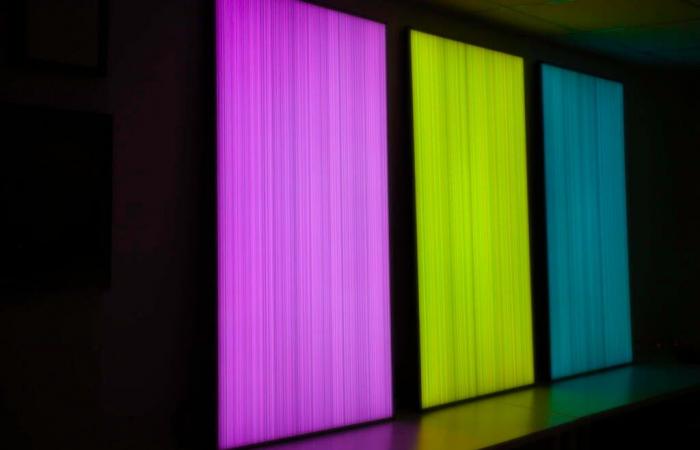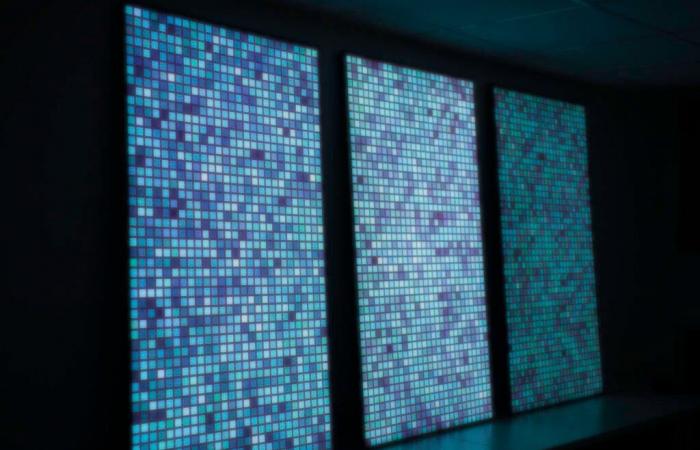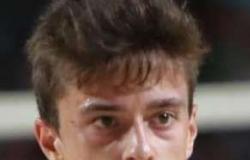There are few artists in Italy who have thought so much and fruitfully about the digital world, and its sudden evolution and artistic application, as Davide Maria Coltro (Verona, 1967), known for being “the inventor of the electronic panel”. This electronic painting – which became famous with its participation in the Italian Pavilion at the 54th Venice Biennale – assigns abstract connotations to the media language and encodes fundamental elements (such as bits and pixels) in a new synthetic and philosophical combination. Now, his most recent production is on display at MA*GA Museum Of Gallarate.
Davide Coltro’s exhibition at MA*GA
Curated by Alessandro Castiglioni with the critical contribution of Elena Pontiggia (open until 1 September 2024), the exhibition Media Abstraction is in continuity with a broader analysis of abstract art, from the Concrete Art Movement to Analytical Painting. Coltro interprets these themes as the dialogue between art and science, the new cognitive frontiers of Visual Studies and the redefinition of the relationship between art and spirituality, a perspective according to which the museum here becomes a place of contemplation. In parallel with the exhibition, the artist aims to come into direct contact with the public, on the one hand connecting to the city fabric of Gallarate with his own works, transmitted in digital totems scattered around the city (according to the concept of “Civic Framework” already brought in Shanghai in 2006); on the other, combining the exhibition with a permanent workshop program on the relationship between technological physicality and digital immateriality.
The article continues below
The interview with Davide Maria Coltro
How does your most recent production differ from historical works?
At the beginning I experimented with painting with alternative materials, after some time I became passionate about digital painting and through printing technologies: consequently the intuition came of being able to use displays as canvases, no longer as places to project images but surfaces of birth and transformation of painting. For a long time I was accompanied by a certain distance from abstract art, which seemed residual to me but, in recent years it has totally involved me. American abstract expressionism, constructivist rigor, kinetic and programmed art, European analytical painting together with relational and public art entered the construction of my shaky cultural edifice. It was like facing a new beginning, starting again from the rods and the dots. I can already consider some series as cornerstones of the first stage of this journey, which began in 2018: Strings, Diapason, Mosaic, Metropolis, Code.
How would you define “painting beyond matter”?
Art originates from needs that are often inexpressible through words and concepts and is in turn transmitted, generating stimuli that move the spirit without necessarily calling into question the rational part that formulates language. “Painting beyond matter” uses principles common to traditional painting medialized by electronic and information technologies: the monitor is used to generate chromatic fields that emit laminal light, the color is visible but is not materially deposited on the iridescent surface because, quoting Nicholas Negroponte, this painting has gone from “atoms to bits”, thanks to the code that is executed by the Quadro Mediale, continuously reconfiguring the pixels in an uninterrupted media flow. Somehow I returned to a principle of color untouchability.
How does the reflection on spirituality fit into the context of Visual Studies?
It is an interesting and insidious question, because it seems that the theoretical and scientific urgencies of Visual Studies do not have great points of contact with the spiritual part of man. WJT Mitchell, one of the greatest theorists of Visual Culture, includes relationship among its foundations image/picture, where “picture” is the physical entity, the support or media that hosts the image, while “image” identifies an immaterial property, the essence that makes an image identifiable even if transferred from one medium to another, or even just as a mental image. Of this, there is an authoritative assumption in the Phenomenology of Hegel. I believe that Visual Studies opens up new perspectives even outside their line of political, social and economic criticism, rooted in a filtered and updated historical materialism: I take into consideration the long history of sacred images and their communicative power, with particular attention to the category of “ex voto” and “holy relics”.
Digital art according to Davide Coltro
What do you think is the direction of digital art? And what, if any, is the contribution of Artificial Intelligence in this scenario?
Digital art, which began its activities in the 1970s and 1980s, with experimental practices and purposes completely divergent from current ones, had a committed and coherent theoretical component. In our present time it has been enriched with means that are too advanced compared to artistic reflection which, in my opinion, lacks synchrony with these accelerated scenarios. Except for a few cases of artists who have followed committed and coherent research, we find ourselves immersed in a proliferation of spectacularizations that belong to entertainment, visual design and creativity but little to art. NFTs have been the litmus test of a superficiality that has confused many. Answering your question, I think that a systematic theoretical reflection is necessary on the part of artists, freed from the yoke of technology and its enslavement. Without this effort it will be difficult to escape from a spiral of banality that prevents the flowering of significant and mature works with respect to these new media which must be metabolized and not just dissected and classified in their social effects. Welcome to AI which represents the synthesis of the technological progress in question, it should be considered a tool, although exceptionally advanced, without idiosyncrasies or irrational impulses. It will be a companion in the future and I believe that even now the process is irreversible, there will be many changes like a big wave that will be better to surf than to be overwhelmed by it.
How did you adapt the concept of the Civic Framework presented in China to the environment (and citizens) of Gallarate?
Many years have passed since I attempted this experiment in expanding the exhibition space. It is necessary to consider the different arrangement of the “Remote Artistic Terminals”, which can be seen by a large number of people without any of them having chosen to access a specific exhibition location: a relational map is drawn that involves the heterogeneous public in transit, the work itself as a media flow, the consent of the managers of public resources, the urban space experienced by the community and finally the artist as the origin of the process. With great generosity the Department of Culture has made available all the digital information points available with concrete civic and cultural action. These medium format totems, vertical and anchored to the ground, can be observed up close like the works displayed at the MA*GA Museum. The difference in use is substantial compared to the large screens I used way back in 2006 in Shanghai because close observation creates greater empathy between the work and its users. Transforming painting into a digital flow is the project I have been developing for 25 years, my message repeats that art is a value that fuels life, and I think it is a path to follow to the end.
Is yours a “difficult” art? With this solo show, are you aiming for professionals or instead reaching a wider audience?
I don’t think we can speak of a “difficult art”, my works have always had an aesthetic “shielding” that has made them very popular with the most heterogeneous public, an aspect that has deceived those who have not been able to overcome this filter. Probably, the light use and a general cultural disengagement have contributed to generating lexical and semantic gaps, blocking many from the first interpretation. In recent years, two publications have been released with informative but scientifically committed intentions, to nourish the expectations that have grown around the outcome of my research, written by Alberto Fiz and Elena Pontiggia, and both have proven to be very useful in filling the interpretative gaps. The MA*GA project now intends to eliminate the misunderstandings of reading the old scenario, and together with the curator Castiglioni, Pontiggia and other critics we are working on a volume that we hope will be a source of interpretation for this new, entirely “non-objective” line of investigation. The exhibition represents only part of the project which intends to facilitate the use and understanding of my work, sharing the experience with specially prepared educational workshops and guided tours. The ambitious aim is to reach both professionals and the wider public.
Giulia Giaume
Artribune is also on Whatsapp. Simply click here to subscribe to the channel and always be updated







